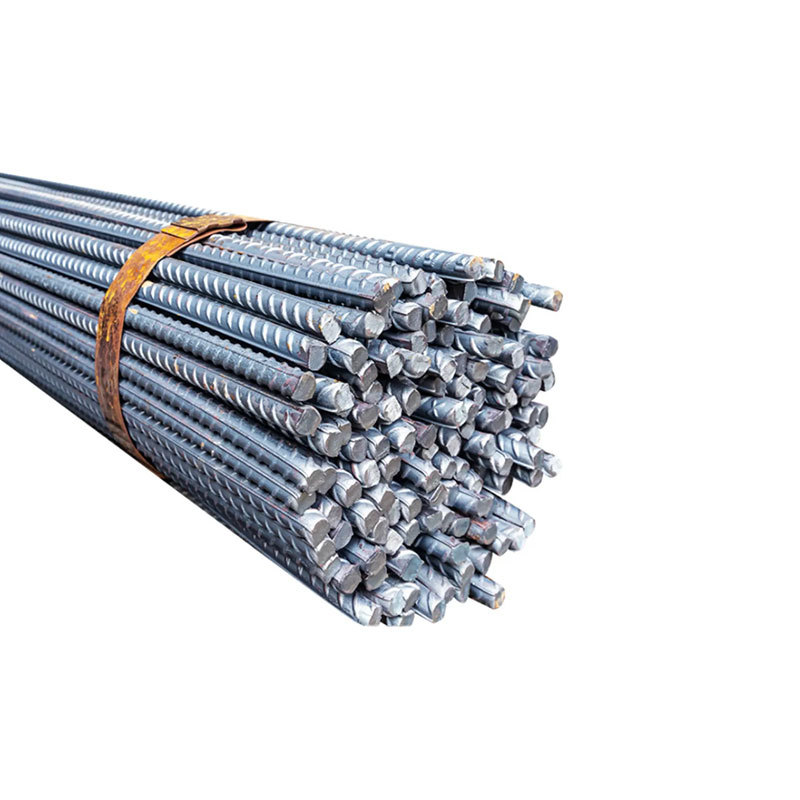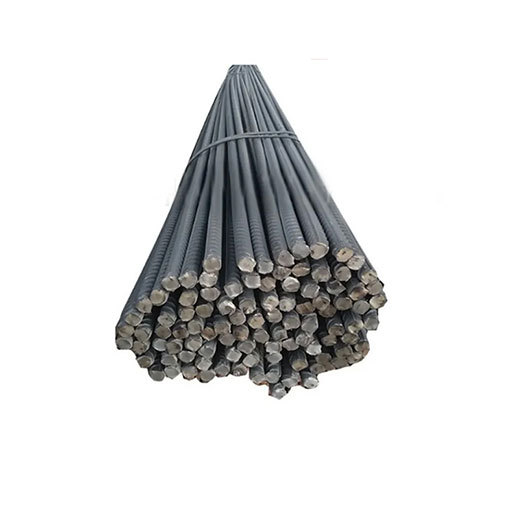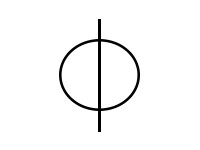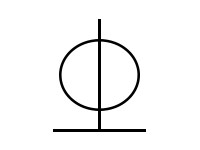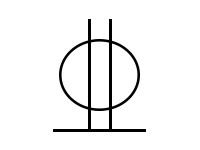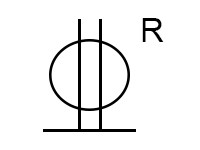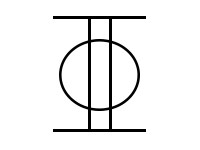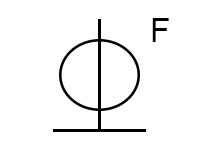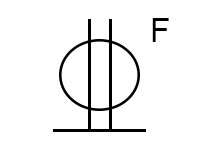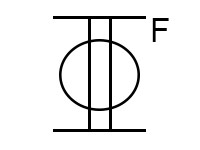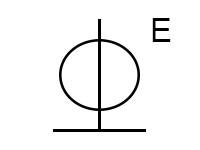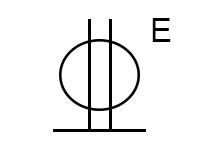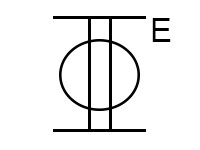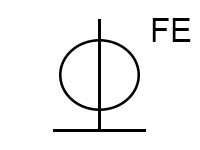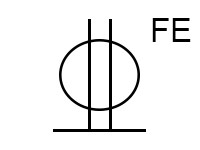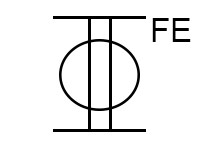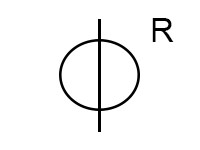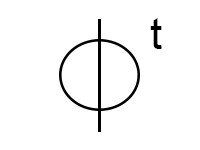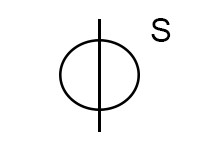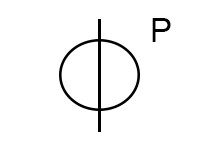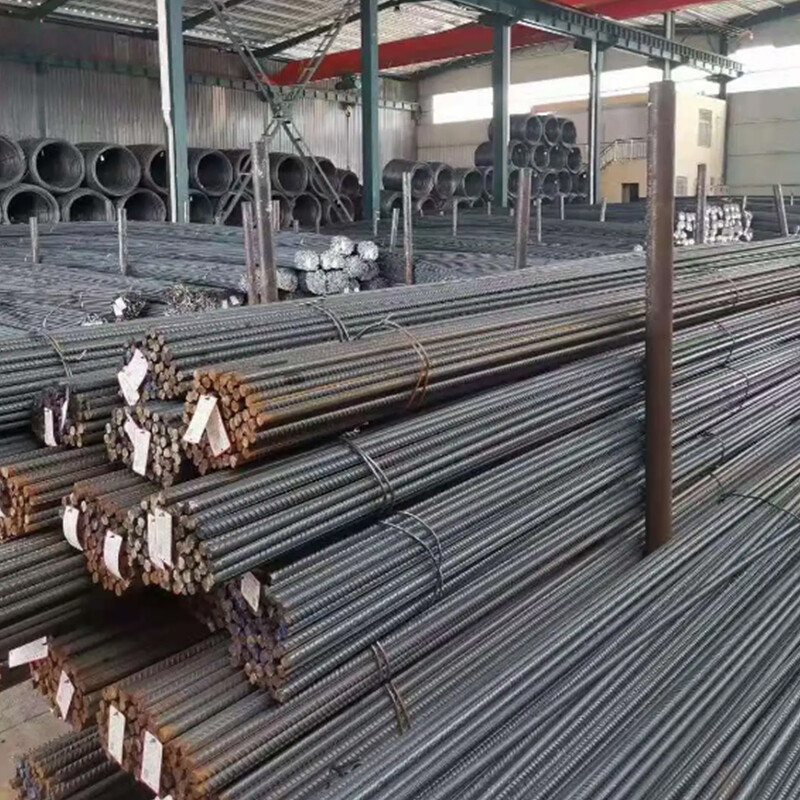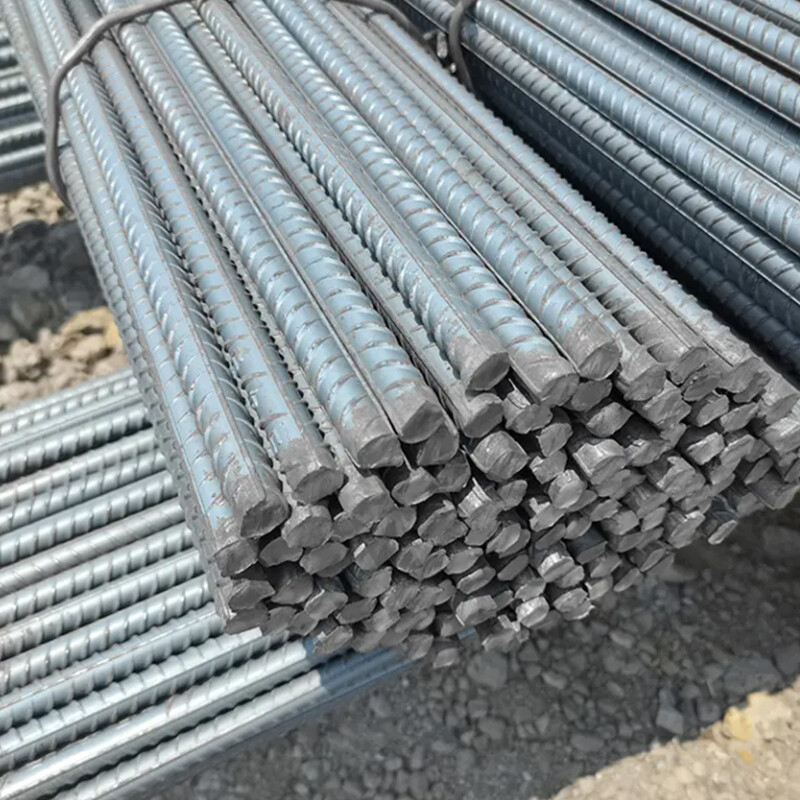PRODUCT
Introduction to Steel Rebar
| |
| Rebar refers to steel for reinforced concrete and prestressed reinforced concrete. Its cross-section is circular, sometimes square with rounded corners. There are many types of steel bars, which are usually classified according to chemical composition, production process, rolling shape, supply form, diameter size, and use in structures: | |
| 1. Classification according to diameter size | |
| Steel Wire | Diameter 3-5mm |
| Thin Steel Rebars | Diameter 6-10mm |
| Thick Steel Rebars | Diameter greater than 22m |
| 2. Classification according to production technology | |
| hot rolled steel Rebars | Hot rolling process |
| Cold rolled steel Rebars | Cold rolling process |
| cold drawn steel Rebars | Cold Drawn process |
| Heat-treated steel Rebars | Heat-treated process,which are made from grade IV steel Rebars,higher strength. |
| 3. Classification according to rolling shape | |
| plain round steel bars (Smooth Reinforcing Bar) | Class I steel bars (Q300 steel bars) are rolled into smooth circular cross-sections and are supplied in the form of discs, with a diameter of not more than 10mm and a length of 6m~12m. |
| Ribbed steel bars | There are three types: spiral, herringbone and crescent. Generally, Grade II and III steel bars are rolled into herringbone shapes, and Grade IV steel bars are rolled into spiral and crescent shapes. |
| Steel wires | Divided into low-carbon steel wires and carbon steel wires) and steel strands. |
| Cold-rolled twisted steel bars | cold-rolled and cold-twisted. |
| 4. Classification according to mechanical properties | |
| Grade I Steel Rebars | 300/420 |
| Grade II Steel Rebars | 335/455 |
| Grade III Steel Rebars | 400/540 |
| Grade IV Steel Rebars | 500/630 |
| 5. Classification according to function in structure | |
| Tension Rebars | Steel Rebars that bear tensile and compressive stress. |
| Hoop Rebars | Bear part of the diagonal tensile stress and fix the position of the tension bars, mostly used in beams and columns. |
| Frame Rebars | Used to fix the position of the steel hoops in the beam, forming the steel skeleton in the beam. |
| Distribution Rebars | Used in roof panels and floor slabs, arranged vertically with the tension bars of the slabs, evenly transferring the weight to the tension bars, fixing the position of the tension bars, and resisting the temperature deformation caused by thermal expansion and contraction. |
| Others Rebars | Structural bars configured due to component construction requirements or construction and installation needs. Such as waist bars, embedded anchor bars, prestressed bars, rings, etc. |
CONTACT US
Hot Rolled Steel Rebars-1
|
| 1. Common symbols for hot-rolled steel Rebars |
| H--hot rolled R--ribbed B--steel bar 300--500--other steel grades F--fine grain hot rolled steel E---high-demand seismic structural steel P--plain steel (round steel) |
| Hot rolled side reinforcement grade and diameter symbol | ||||||
| Strength grade code | shape | Steel Type | Nominal diameter (mm) | Symbol(level) | Main Application | Common Materials |
| HPB235 | Smooth cylindrical shape | Low carbon steel | 8--20 |
| Non-prestressed | Q235 |
| HRB335 | With crescent-shaped ribs | Alloy steel | 6--50 |
| Non-prestressed, prestressed | 20MnSi |
| HRB400 | With crescent-shaped ribs | Alloy steel | 6--50 |
| Non-prestressed, prestressed | 25MnSi |
| RRB40 | With crescent-shaped ribs | Alloy steel | 6--50 |
| Prestressed | 40Si2Mnv |
| Symbol comparison table | |||
| type | Brand |  symbol symbol | Software Code |
| Hot-rolled plain round steel bar | HPB300 |
| A |
| Ordinary hot-rolled ribbed steel bar | HRB335 |
| B |
| Ordinary hot-rolled ribbed steel bar | HRB400 |
| C |
| Residual heat treated ribbed steel bar | RRB400 |
| D |
Ordinary hot-rolled ribbed steel bar | HRB500 |
| E |
| Fine grain tropical rib steel bar | HRBE335 |
| BF |
| Fine grain tropical rib steel bar | HRBF400 |
| CF |
| Fine grain tropical rib steel bar | HRBF500 |
| EF |
| Ordinary hot rolled earthquake resistant steel bar | HRB335E |
| BE |
| Ordinary hot rolled earthquake resistant steel bar | HRB400E |
| CE |
| Ordinary hot-rolled earthquake-resistant steel bars | HRB500E |
| EE |
| Fine-grained hot-rolled earthquake-resistant steel bars | HRBF335E |
| BFE |
| Fine-grained hot-rolled earthquake-resistant steel bars | HRBF400E |
| CFE |
| Fine-grained hot-rolled earthquake-resistant steel bars | HRBF500E |
| EFE |
| Cold-rolled ribbed steel bars |
| L | |
| Cold rolled twisted steel bars |
| N | |
| Prestressed steel strands |
| ||
| Prestressed steel wire |
| ||
| 2.Marking of steel bars | |
| Mark the number, diameter and grade of steel bars | Mark the grade, diameter and center distance of adjacent copper bars of the steel bars |
| 3Ф20 | Ф8@200 |
| 3: indicates the number of steel bars Ф: indicates the steel bar grade and diameter symbol 20: indicates the steel bar diameter | Ф: Indicates the grade and diameter of the steel bar 8: Indicates the diameter of the steel bar @: Symbol for equal center distance 200: Center distance between adjacent steel bars (≤200mn) |
| 3.Hot rolled ribbed steel bar production steps |
| The production of hot-rolled ribbed steel Rebars mainly includes the following steps: (1) Heat the square billet to 1000-1040℃. (2) After descaling with high-pressure water, it is sent to the rough rolling unit for 6 passes, the intermediate rolling unit, and the finishing rolling unit. There is a #1 flying shear between the rough rolling unit and the intermediate rolling unit. There is a 2# flying shear between the 12th pass and the 13th pass, a cooling device is installed after the finishing mill, and a 3# flying shear is installed after that. (3) Finally, it goes through the cooling bed, cold shearing machine, collection roller, and packaging to complete the processing. These are the basic production steps of hot-rolled ribbed steel Rebars. Note that different manufacturers may have different process details and technical parameters. |
CONTACT US
Hot Rolled Steel Rebars-2
|
| 1.Nominal diameter, nominal cross-sectional area and theoretical weight of steel bars | ||||||||||
| Nominal diameter (mm) | Nominal cross-sectional area of different number of steel bars (mm²) | Theoretical weight of a single steel bar (kg/m) | ||||||||
| 1 | 2 | 3 | 4 | 5 | 6 | 7 | 8 | 9 | ||
| 6 | 28.3 | 57 | 85 | 113 | 142 | 170 | 198 | 226 | 255 | 0.222 |
| 8 | 50.3 | 101 | 151 | 201 | 252 | 302 | 352 | 402 | 453 | 0.395 |
| 10 | 78.5 | 157 | 236 | 314 | 393 | 471 | 550 | 628 | 707 | 0.617 |
| 12 | 113.1 | 226 | 339 | 452 | 565 | 678 | 791 | 904 | 1017 | 0.888 |
| 14 | 153.9 | 308 | 461 | 615 | 769 | 923 | 1077 | 1231 | 1385 | 1.21 |
| 16 | 201.1 | 402 | 603 | 804 | 1005 | 1206 | 1407 | 1608 | 1809 | 1.58 |
| 18 | 254.5 | 509 | 763 | 1017 | 1272 | 1527 | 1781 | 2036 | 2290 | 2.00(2.11) |
| 20 | 314.2 | 628 | 942 | 1256 | 1570 | 1884 | 2199 | 2513 | 2827 | 2.47 |
| 22 | 380.1 | 760 | 1140 | 1520 | 1900 | 2281 | 2661 | 3041 | 3421 | 2.98 |
| 25 | 490.9 | 982 | 1473 | 1964 | 2454 | 2945 | 3436 | 3927 | 4418 | 3.85(4.10) |
| 28 | 615.8 | 1232 | 1847 | 2463 | 3079 | 3695 | 4310 | 4926 | 5542 | 4.83 |
| 32 | 804.2 | 1609 | 2413 | 3217 | 4021 | 4826 | 5630 | 6434 | 7238 | 6.31(6.65) |
| 36 | 1017.9 | 2036 | 3054 | 4072 | 5089 | 6107 | 7125 | 8143 | 9161 | 7.99 |
| 40 | 1256.6 | 2513 | 3770 | 5027 | 6283 | 7540 | 8796 | 10053 | 11310 | 9.87(10.34) |
| 50 | 1963.5 | 3928 | 5892 | 7856 | 9820 | 11784 | 13748 | 15712 | 17676 | 15.42(16.28) |
| Note: The valuesin brackets are the valuesof prestressed threaded steel bars. | ||||||||||
| 2. Dimensions and specifications of ribbed steel bars |
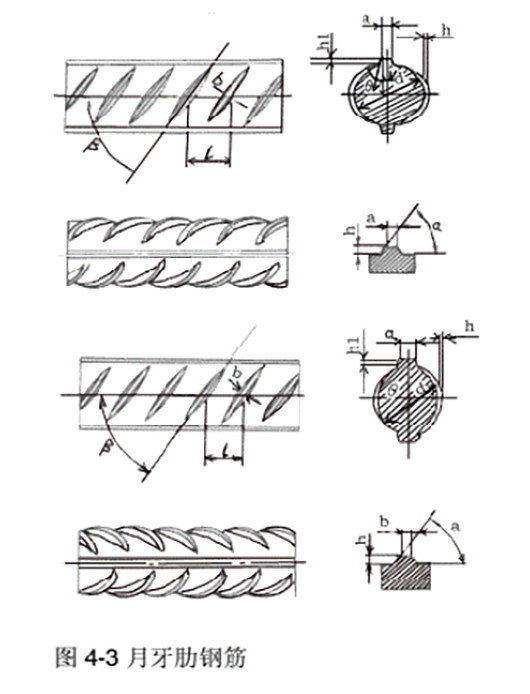 |
| d-inner diameter of steel bar a-angle of transverse rib h-height of transverse rib B-angle between transverse rib and axis h1-height of longitudinal rib 0-angle of longitudinal rib a-width of longitudinal rib top 1-distance between transverse ribs b-width of transverse rib top |
| Dimensions of ribbed steel bars (mm) | |||||||||||
| Nominal Diameter | Inner diameter d | Transverse rib height h | Longitudinal rib height h1 | Transverse rib width b | Longitudinal rib width a | Spacing f | Maximum gap at the end of the transverse rib(10% chord length of the nominal circumference) | ||||
| Nominal size | Permissible deviation | Nominal size | Permissible deviation | Nominal size | Permissible deviation | Nominal size | Permissible deviation | ||||
| 6 | 5.8 | 0.3 | 0.6 | +0.3 -0.2 | 0.6 | ±0.3 | 0.4 | 1 | 4 | ±0.5 | 1.8 |
| 8 | 7.7 | ±0.4 | 0.8 | +0.4 -0.2 +0.4 | 0.8 | ±0.5 | 0.5 | 1.5 | 5.5 | 2.5 | |
| 10 | 9.6 | 1 | -0.3 | 1 | 0.6 | 1.5 | 7 | 3.1 | |||
| 12 | 11.5 | 1.2 | ±0.4 | 1.2 | ±0.8 | 0.7 | 1.5 | 8 | 3.7 | ||
| 14 | 13.4 | 1.4 | 1.4 | 0.8 | 1.8 | 9 | 4.3 | ||||
| 16 | 15.4 | 1.5 | 1.5 | 0.9 | 1.8 | 10 | 5.0 | ||||
| 18 | 17.3 | 1.6 | +0.5 -0.4 | 1.6 | 1.0 | 2 | 10 | 5.6 | |||
| 20 | 19.3 | ±0.5 | 1.7 | ±0.5 | 1.7 | 1.2 | 2 | 10 | ±0.8 | 6.2 | |
| 22 | 21.3 | 1.9 | ±0.6 | 1.9 | ±0.9 | 1.3 | 2.5 | 10.5 | 6.8 | ||
| 25 | 24.2 | 2.1 | 2.1 | 1.5 | 2.5 | 12.5 | 7.7 | ||||
| 28 | 27.2 | ±0.6 | 2.2 | 2.2 | 1.7 | 3 | 12.5 | ±1.0 | 8.6 | ||
| 32 | 31.0 | 2.4 | +0.8 -0.7 | 2.4 | ±1.1 | 1.9 | 3 | 14 | 9.9 | ||
| 36 | 35.0 | 2.6 | +1 -0.8 | 2.6 | 2.1 | 3.5 | 15 | 11.1 | |||
| 40 | 38.7 | ±0.7 | 2.9 | ±1.1 | 2.9 | 2.2 | 3.5 | 15 | 12.4 | ||
| 50 | 48.5 | ±0.8 | 3.2 | ±1.2 | 3.2 | ±1.2 | 2.5 | 4 | 16 | 15.5 | |
| Permissible deviation of quality of ribbed steel bars | |
| Nominal diameter/mm | Deviation between actual mass and theoretical mass (%) |
| 6—12 | ±7 |
| 14—20 | ±5 |
| 22—50 | ±4 |
| 3. Brand and chemical composition | ||||||
| Brand | Chemical composition (mass fraction) (%)≤ | |||||
| C | Si | Mn | P | S | Ceq | |
| HRB 335 | 0.25 | 0.8 | 1.6 | 0.045 | 0.045 | 0.52 |
| HRB 400 | 0.25 | 0.8 | 1.6 | 0.045 | 0.045 | 0.54 |
| HRB 500 | 0.25 | 0.8 | 1.6 | 0.045 | 0.045 | 0.55 |
Note: 1. The grade of hot-rolled ribbed steel bars is composed of HRB and the minimum yield point of the grade. H, R, and B are the first letters of the three words hot-rolled (H0tr011ed), ribbed (Ribbed), and bars (Bars) respectively. Hot-rolled ribbed steel bars are divided into three grades: HRB 335, HRB 400, and HRB 500. 2. The carbon equivalent Ceq (%) value can be calculated as follows:Ceq=Wc+WMn /6+(WCr+WV+WMO)/5+(WCu+WNi)/15Wc and WMn are the mass fractions of C and Mn respectively. | ||||||
| 4. Mechanical properties | ||||
| Brand | Nominal diameter/mm | σs(or σp0.2)/ MPa | σb / MPa | δ5(%) |
| ≥ | ||||
| HRB 335 | 6—25 28—50 | 335 | 490 | 16 |
| HRB 400 | 6—25 28—50 | 400 | 570 | 14 |
| HRB 500 | 6—25 28—50 | 500 | 630 | 12 |
CONTACT US
Cold Rolled Steel Rebars
| |
| 1.Dimensions expression method | |
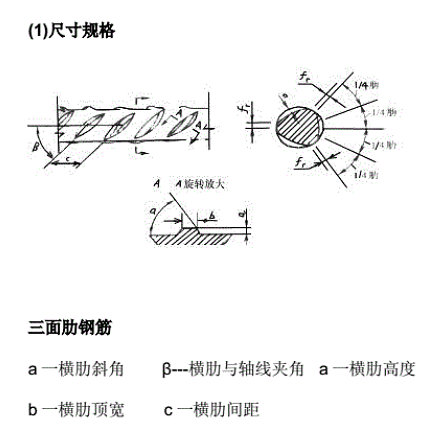 Three-sided rib reinforcementa--transverse rib angle Three-sided rib reinforcementa--transverse rib angleβ--angle between transverse rib and axis a--transverse rib height b--transverse rib top width c--transverse rib spacing | |
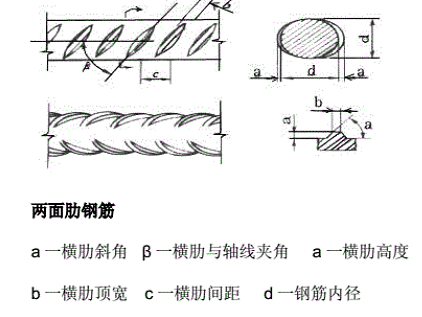 Two-sided rib reinforcementa- transverse rib angle Two-sided rib reinforcementa- transverse rib angleβ- transverse rib and axis angle a- transverse rib height b- transverse rib top width c- transverse rib spacing d- reinforcing bar inner diameter |
| 2.Dimensions and specifications | |||||||||
| Dimensions of three-sided rib steel bars | |||||||||
| Nominal Diameter | Nominal cross-cutting area | Theoretical quality | Rib midpoint height | Height at 1/4 of rib na/mm | Rib top width b /mm | Rib distance | Relative rib area fr ≥ | ||
| a | Allowable deviation | c/mm | Allowable deviation (%) ≥ | ||||||
| /mm | /mm² | /(kg/m) | ≤ | ||||||
| mm | |||||||||
| (4) | 12.6 | 0.099 | 0.3 | +0.10 -0.5 | 0.24 | ~0.2d | 4 | ±15 | 0.036 |
| 5 | 19.6 | 0.154 | 0.32 | 0.26 | 4 | 0.039 | |||
| 6 | 28.3 | 0.222 | 0.4 | 0.32 | 5 | 0.039 | |||
| 7 | 38.5 | 0.302 | 0.46 | 0.37 | 5 | 0.045 | |||
| 8 | 50.3 | 0.395 | 0.55 | 0.44 | 6 | 0.045 | |||
| 9 | 63.6 | 0.499 | 0.75 | 0.6 | 7 | 0.052 | |||
| 10 | 78.5 | 0.617 | 0.75 | 0.6 | 7 | 0.052 | |||
| (12) | 113.1 | 0.888 | 0.97 | 0.77 | 8.4 | 0.056 | |||
Note: 1.The nominal diameter in brackets is not recommended. 2. The angle β between the rib and the steel bar axis is 40°-60°. The angle a between the two sides of the rib and the steel bar surface is greater than or equal to 45°. The sum of the rib gaps should not exceed 20% of the nominal circumference. 3. The allowable deviation of the theoretical quality is not more than +4%. | |||||||||
| Dimensions of double-sided rib steel bars | |||||||||||
| Nominal diameter /mm | Inner diameter d/mm | Nominal cross-sectional area/mm² | Theoretical quality /(kg/m) | Rib midpoint height | Rib 1/4 height/mm | Rib top width b/mm | Rib distance | Relative rib area fr≥ | |||
| Standard size | allowable tolerance | a | Permissible deviation≥ | c | Permissible deviation≥ | ||||||
| mm | |||||||||||
| 5 | 4.8 | ±0.2 | 19.6 | 0.154 | 0.32 | +0.10 -0.05 | 0.2 | -0.2d | 4 | ±15 | 0.039 |
| 6 | 5.8 | 28.3 | 0.222 | 0.4 | 0.27 | 5 | 0.039 | ||||
| 7 | 6.6 | ±0.4 | 38.5 | 0.302 | 0.46 | 0.31 | 5 | 0.045 | |||
| 8 | 7.6 | <,SPAN style="FONT-FAMILYArial; FONT-SIZE9pt; mso-font-kerning 0pt” lang=EN-US>50.3 | 0.395 | 0.55 | 0.37 | 6 | 0.045 | ||||
| 9 | 8.6 | 63.6 | 0.499 | 0.75 | 0.5 | 7 | 0.052 | ||||
| 10 | 9.5 | 78.5 | 0.617 | 0.75 | 0.5 | 7 | 0.052 | ||||
| 12 | 11.5 | 113.1 | 0.888 | 0.97 | 0.65 | 8.4 | 0.056 | ||||
Note: 1.The allowable deviation of theoretical mass is not more than +(-)4%. 2. Longitudinal ribs with a height not more than 0.5a are allowed. | |||||||||||
| 3. Model standards and chemical composition | |||||||
| Grade and chemical composition of cold drawn ribbed steel bars | |||||||
| Level code | Brand | Chemical composition (mass fraction)(%) | |||||
| C | Si | Mn | Ti | S ≤ | P ≤ | ||
| LL 550 | Q215 | 0.09—0.15 | ≤0.30 | 0.25—0.55 | 0.05 | 0.045 | |
| LL 650 | Q235 | 0.14—0.22 | ≤0.30 | 0.30—0.65 | 0.05 | 0.045 | |
| LL 800 | 24MnTi | 0.19—0.27 | 0.17—0.37 | 1.20—1.60 | 0.01—0.05 | 0.045 | 0.045 |
Note: The residual content (mass fraction) of chromium, nickel and copper shall not exceed 0.30% respectively, the residual content (mass fraction) of arsenic shall not exceed 0.08%, and the content (mass fraction) of nitrogen shall not exceed 0.08%. If the supplier guarantees, no inspection is required. | |||||||
| 4. Mechanical properties | |||||||
| Mechanical and process properties of cold drawn ribbed steel bars | |||||||
| Level code | Yield Strength σ0.2 | Tensile strength σb | Elongation(%)≥ | 180° cold bending test, d is the bending center diameter, a is the steel bar diameter | Stress relaxation σc0n=0.7σb | ||
| MPa≥ | δ10 | δ100 | 1000h (%)≤ | 10h (%)≤ | |||
| LL 550 | 500 | 550 | 8 | d=3a | |||
| LL 650 | 520 | 650 | 4 | d=4a | 8 | 5 | |
| LL 800 | 640 | 800 | 4 | d=5a | 8 | 5 | |
| 5. Production process of cold-rolled ribbed steel bars |
| The cold-rolled ribbed steel bar production process is a technology that processes strip steel into ribbed steel bars after cold-rolling it on a bring-in machine. Its main process flow is as follows: 1. Uncoiling steel coil The steel coil uncoiling process is to take out the steel coils stored in the steel coil warehouse as required, insert them into the powerful coiler through the mandrel, and then twist the mandrel to slowly unwind the steel coils. 2. Heating and tempering After the steel coil is uncoiled, it is heated and tempered to maximize the cold working performance of the steel coil for subsequent operations. 3. Preparation process Roll the steel coil to the processing area, fix its flatter position, check the steel coil for depression, and then cut it into steel bars of the required length. 4. Cold rolling forming This link is the core link of the cold-rolled ribbed steel bar production process. Its purpose is to process and deform the steel bars by bending, flattening, etc., to form a regular ribbed shape. This process requires the cooperation between the steel coil and two traction rollers, and there is a spacer above the ground to complete the bending and deformation of the steel bars. 5.Water cooling cutting The final step in the cold-rolled ribbed steel production process is to use a water-cooled cutting machine to cut the bars to the required length and clean them. |
CONTACT US

CONTACT US

